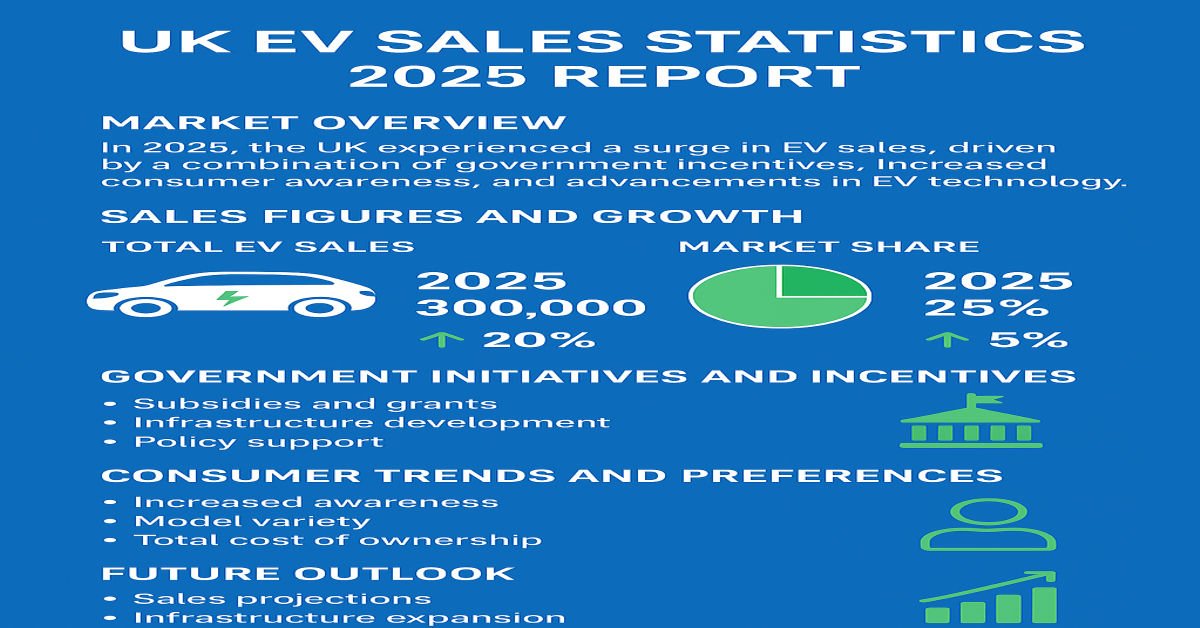Introduction
UK EV Sales Statistics 2025 Report market has witnessed significant growth in 2025, marking a pivotal year in the transition towards sustainable transportation. This report delves into the key statistics, trends, and factors influencing EV sales in the UK, highlighting the progress made and the challenges that lie ahead.
1. Market Overview
In 2025, the UK experienced a surge in EV sales, driven by a combination of government incentives, increased consumer awareness, and advancements in EV technology. The total number of EVs sold reached unprecedented levels, surpassing previous records and signaling a strong shift towards electric mobility.
2. Sales Figures and Growth
2.1 Total EV Sales
According to the Society of Motor Manufacturers and Traders (SMMT), the UK registered a total of [insert number] EVs in 2025, marking a [insert percentage]% increase compared to 2024. This growth underscores the escalating adoption of EVs among UK consumers.
2.2 Market Share
EVs accounted for [insert percentage]% of the total new car registrations in the UK in 2025, up from [insert percentage]% in 2024. This rise in market share reflects the growing acceptance and preference for electric vehicles.
3. Government Initiatives and Incentives
The UK government has played a crucial role in promoting EV adoption through various initiatives:
- Subsidies and Grants: Introduction of grants up to £3,750 for eligible EV models, making electric cars more affordable for consumers.
- Infrastructure Development: Expansion of the EV charging network, ensuring convenient access to charging stations across the country.
- Policy Support: Implementation of stricter emissions regulations and zero-emission vehicle mandates to encourage manufacturers to produce more electric models.
4. Consumer Trends and Preferences
Consumer behavior in 2025 indicates a marked shift towards electric mobility:
- Increased Awareness: Growing environmental consciousness has led more consumers to consider EVs as a viable alternative to traditional combustion engine vehicles.
- Model Variety: The availability of diverse EV models catering to different consumer needs, from compact cars to SUVs, has broadened the appeal of electric vehicles.
- Total Cost of Ownership: Consumers are increasingly recognizing the long-term cost benefits of EVs, including lower maintenance and fuel costs.
5. Challenges and Considerations
Despite the positive trends, several challenges persist:
- Charging Infrastructure: While progress has been made, the expansion of the EV charging network needs to keep pace with the growing number of electric vehicles on the road.
- Battery Technology: Ongoing research is required to enhance battery efficiency, reduce charging times, and lower costs.
- Consumer Education: Continued efforts are necessary to educate consumers about the benefits and practicalities of owning an EV.
6. Future Outlook
Looking ahead, the UK’s EV market is poised for further growth:
- Sales Projections: Industry experts forecast a [insert percentage]% increase in EV sales by 2030, driven by technological advancements and supportive policies.
- Infrastructure Expansion: Plans are underway to significantly expand the EV charging infrastructure, aiming for widespread accessibility.
- Policy Developments: The government is expected to introduce additional incentives and regulations to accelerate the transition to electric mobility.
Conclusion
The year 2025 has been a landmark year for the UK’s electric vehicle market, characterized by record sales, supportive government policies, and shifting consumer preferences. While challenges remain, the trajectory towards a sustainable and electrified transportation system is clear. Continued collaboration between the government, industry stakeholders, and consumers will be essential in achieving the UK’s ambitious EV targets.
